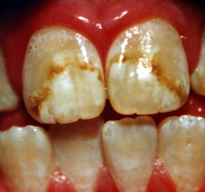Fluoride’s Functions In the Body
Fluoride is known mostly as the mineral that combats tooth decay. It assists in tooth and bone development and maintenance. Fluoride combats tooth decay via three mechanisms:
- Blocking acid formation by bacteria
- Preventing demineralization of teeth
- Enhancing remineralization of destroyed enamel
Fluoride was first added to drinking water in 1945 in Grand Rapids, Michigan; now over 60 percent of the US population consumes fluoridated drinking water. The Centers for Disease Control and Prevention (CDC) has reported that fluoridation of water prevents, on average, 27 percent of cavities in children and between 20 and 40 percent of cavities in adults. The CDC considers water fluoridation one of the ten great public health achievements in the twentieth century[1].
The optimal fluoride concentration in water to prevent tooth decay ranges between 0.7 and 1.2 milligrams per liter. Exposure to fluoride at three to five times this concentration before the growth of permanent teeth can cause fluorosis, which is the mottling and discoloring of the teeth.
Fluoride’s benefits to mineralized tissues of the teeth are well substantiated, but the effects of fluoride on bone are not as well known. Fluoride is currently being researched as a potential treatment for osteoporosis. The data are inconsistent on whether consuming fluoridated water reduces the incidence of osteoporosis and fracture risk. Fluoride does stimulate osteoblast bone-building activity, and fluoride therapy in patients with osteoporosis has been shown to increase BMD. The Food and Drug Administration has not approved fluoride for the treatment of osteoporosis mainly because its benefits are not sufficiently known, and it has several side effects, including frequent stomach upset and joint pain. The doses of fluoride used to treat osteoporosis are much greater than those in fluoridated water.

Bellingham fluorosis
(Source: Wikimedia Commons, Editmore, Public Domain)
Dietary Reference Intakes
The IOM has given Adequate Intakes (AI) for fluoride, but has not yet developed RDAs. The AIs are based on the doses of fluoride shown to reduce the incidence of cavities, but not cause dental fluorosis. From infancy to adolescence, the AIs for fluoride increase from 0.01 milligrams per day for ages less than six months to 2 milligrams per day for those between the ages of fourteen and eighteen. In adulthood, the AI for males is 4 milligrams per day and for females is 3 milligrams per day. The UL for young children is set at 1.3 and 2.2 milligrams per day for girls and boys, respectively. For adults, the UL is set at 10 milligrams per day.[2]
| Age Group | AI (mg/day) | UL (mg/day) |
|---|---|---|
| Infants (0–6 months) | 0.01 | 0.7 |
| Infants (6–12 months) | 0.50 | 0.9 |
| Children (1–3 years) | 0.70 | 1.3 |
| Children (4–8 years) | 1.00 | 2.2 |
| Children (9–13 years) | 2.00 | 10.0 |
| Adolescents (14–18 years) | 3.00 | 10.0 |
| Adult Males (> 19 years) | 4.00 | 10.0 |
| Adult Females (> 19 years) | 3.00 | 10.0 |
Dietary Sources of Fluoride
| Food | Serving | Fluoride (mg) | Percent Daily Value* |
|---|---|---|---|
| Fruit Juice | 3.5 fl oz. | 0.02-2.1 | 0.7-70 |
| Crab, canned | 3.5 oz. | 0.21 | 7 |
| Rice, cooked | 3.5 oz. | 0.04 | 1.3 |
| Fish, cooked | 3.5 oz. | 0.02 | 0.7 |
| Chicken | 3.5 oz. | 0.015 | 0.5 |
| * Current AI used to determine the Percent Daily Value |
Learning Activities
Technology Note: The second edition of the Human Nutrition Open Educational Resource (OER) textbook features interactive learning activities. These activities are available in the web-based textbook and are not in downloadable versions (EPUB, Digital PDF, Print_PDF, or Open Document).
Learning activities may be used across various mobile devices; however, for the best user experience, it is strongly recommended that users complete these activities using a desktop or laptop computer.
- About Community Water Fluoridation. Centers for Disease Control and Prevention https://www.cdc.gov/fluoridation/about/index.html. Updated May 15, 2024. Accessed July 28, 2025. ↵
- Institute of Medicine. (1997). Dietary Reference Intakes for Calcium, Phosphorus, Magnesium, Vitamin D, and Fluoride. https://www.ncbi.nlm.nih.gov/books/NBK109832/. Accessed July 28, 2025. ↵
- Micronutrient Information Center: Fluoride. Oregon State University, Linus Pauling Institute. lpi.oregonstate.edu/mic/minerals/fluoride . Updated November 2021. Accessed August 14, 2025. ↵
A condition that affects the teeth characterized by brown and black stains and cracked and pitted teeth. It is caused by an excess consumption of fluoride.
A disorder affecting the bones that is characterized as a loss in bone mass, increased bone fragility, and increased risk of fractures.

